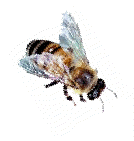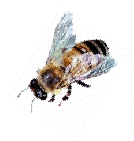Call an exterminator
untrained in bee control:
LET EXPERTS TAKE CARE OF BEES, EXPERTS SAY
By TJ Aulds
The Daily News Galveston County
Published May 20, 2006
There’s a buzz in Galveston County. Bees are popping up everywhere,
turning quiet neighborhood homes into swarming hives.
“It’ll keep you on your toes,” said Darrel Lister, also known as the
Bee Buster. “This is the busiest season I have seen in 30 years.”
No one had to convince one League City homeowner of that Friday afternoon.
The woman, who declined to be interviewed, had called a local pest
control company to remove a beehive that had sprouted under the eaves
of her roof in the Meadow Bends subdivision.
When Wayne Miller of ABC Pest Control was removing the 2-foot-long
hive, its residents went on the attack.
Two of the homeowner’s dogs were stung, as was Miller.
He pulled out an EpiPen, an auto-injector that administers epinephrine,
which is the emergency treatment for severe allergic reactions.
At first, both the homeowner and Miller thought the attack came from
the feared Africanized or killer bees.
That prompted emergency calls to League City police, who sent out
patrol cars and the fire department. Firefighters knocked down the
hive using firefighting foam and, in the process, League City firefighter
Lt. Kevin Casten also was stung.
No one else was injured, and Miller and the dogs were doing fine within
an hour of the attack.
“The bees were really aggressive,” said Miller.
Miller said this is a busy time of the year for him. On his League
City route alone, he is called out to four or five homes a week, he said.
“This has been an unusual year,” he said. “Ordinarily the bees don’t
start to get aggressive until July or August. “But this year I’m already
seeing the calls from all over.”
Calls are coming into the Galveston County Extension Office, too. Gene
Speller, a master gardener and extension volunteer, said the office offers
what Miller and Lister both say is the best advice:
Call an expert.
The extension office even has a list, said Speller.
Lister is hoping people take advantage of that list. Spending $200
to $400 to rid your home of a hive is a wise investment, he said. “It’s
a bad year for bees,” he said. “There is going to be a lot of hurt out
there if people don’t pay attention.”
Lister said anyone looking to avoid being stung needed to follow one
simple rule — avoid the bees altogether. “Look for activity If you see
a bee in your house, then it’s likely he overshot the runway and ended up
inside,” he said. “All they need is a little opening, and they will start
building that hive.”And be extra careful when mowing or pulling out the
weed trimmer, especially near dead trees or stumps.
“Those are just shotguns sitting in the corner waiting to go off,”
Lister said. “It’s really dangerous with these doggone bees.”
© 2006 The Galveston County Daily News. All rights
reserved.
"KILLER" BEES STRIKE CLOSER TO COLORADO
By Rich Tosches
Denver Post Staff Writer
SANTE FE, NM - Joel Simko danced wildly across the roof of the
house, spinning and hopping past the chimney and frantically waving his
long arms over his head. Soon, the lanky man's dance was accompanied by
a great chorus of loud screaming and cursing as a swarm of bees dove onto
his head and face. His ladder was leaned up against the gutter, and he
hit the top rung on a dead run. The ladder slid, and the pest-control
worker found himself plunging 15 feet toward the ground, bolts of pain
shooting through his face and neck as the roar of the swarm grew louder around
his head.
In a scientific discovery of some note, Simko unwittingly found
what entomologists believe is one of the northernmost hives of Africanized
bees in the western United States, a huge swarm that had settled into
a gated community just north of this art mecca. On a slightly less-scientific
note, Simko floundered on the ground, shrieking and thrashing as the attack
raged on. He fought back with the only weapon he had - a baseball cap,
swinging it to get the bees off his face. "When they got me down, they
really came after me," he said. "It was like they knew they had me in
a vulnerable position." A fine observation, according to New Mexico State
University entomologist and African bee expert Carol Sutherland. "These
bees," she said, "are rank, rugged, wild animals. They attack the eyes
and head of whatever they perceive as a threat. "They try to disorient
their attacker and stop it from running away. And then they get it down
on the ground, and they overwhelm it and kill it." Simko got lucky on that
hot August day. He fought his way back to his feet and lurched 25 yards back
to his truck. But the fight wasn't over. A number of bees pursued him into
the truck through an open door. Simko said six of them quickly stung his
face and head. As he slammed the door and pounded away at those bees with
his hat, hundreds of others massed on the windows and windshield, searching
for a crack that would get them inside. "It was like being in a science fiction
movie," Simko said. "It was absolutely terrifying."
...Brian Gianardi is a construction supervisor who was attacked
the same day by the same swarm that had Simko shuffling across the
roof of the home 15 miles northwest of the city. The homeowners were
at their other residence in San Francisco, giving Gianardi and Simko
time to dig in for the weeks-long battle against the raging bees - Sutherland
estimated there could have been "tens of thousands" of bees in the colony,
though no one knows for sure - that built a hive on the front porch.
"The first thing I see," said Gianardi, "is a plumber's assistant
get out of his truck and start yelling and running around, waving his
hands over his head. To be honest, I thought it was pretty funny. Then
the bees came after me and started stinging ... and it wasn't so funny
anymore." Eventually, Simko brought a bee suit from the New Mexico Pest
Control facility where he works. Gianardi donned the suit and headed for
the hive. "I'm swinging a broom at them, and they just went nuts," he
said. "Thousands of them are dive-bombing me, aiming for my face. "They're
bouncing off the wire face mask and the helmet. It sounded like popcorn
popping. They were in total attack mode." Simko didn't go to the hospital
but said he felt sick and as though he were suffering a heart attack the
night after the bee attack. Sutherland said the men were lucky. "A lot
of bad things happen to people in that situation," she said. "When these
Africanized bees sting, it releases a venom the others can smell. When
they smell that chemical, they go into a rage and they all attack. The
more they sting, the more agitated the colony becomes."
Simko and Sutherland said last week that the Africanized bees
are no longer at the house - having packed up and flown off to parts
unknown. Today, Simko, whose face was badly swollen after the attack,
has recovered. Except for his lingering fear of small aircraft. "The
horrible buzzing as they attacked me, that's what I remember," he said.
"When I'm outside now and hear anything like that, I get pretty jumpy.
The other day a Piper Cub flew overhead, and I felt that split-second
of terror." (Rich Tosches, Denver Post, 10/16/05.)
***Pest control companies,
untrained in bee removal, put themselves and the public at risk.
Bee removals should be done by Bee Removal Specialists
or beekeepers. Contaminating an area with toxic powders and sprays sometimes
works but more often drives the bees deeper into a building where they
set up a new nest, avoiding the sprays or powders. Physical, live removal
of bees and comb is the only sure way to handle honeybee infestations.
|



